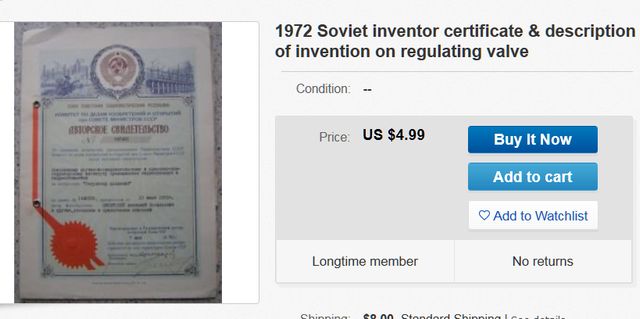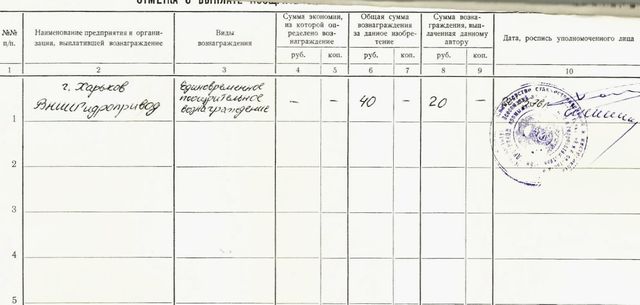Tuesday, November 12, 2019
Followup on Inventor Certificates
Recently I wondered how the Soviet system treated inventors.
= = = = = START REPRINT:
In 1929 the 'cruel annoyances' were familiar. The ITT author knew that the sole purpose of patents is to STOP innovation and KILL inventors. He was ruefully unsurprised to find the same situation in 1797. Nothing has changed. Patents still serve to halt and impoverish real inventors.
Well, how about the Soviet system? We know that the USSR treated scientists better. They were trained properly, and they were given tremendous respect and comparative freedom to think and work.
Did inventors get similar treatment? The patent situation is unfamiliar. Fortunately I found a 1973 US trade document aimed at increasing trade with Russia:
 = = = = = END REPRINT.
So I bought one of those certificates from Ebay, mainly to see details of the 'payout'. It came in the mail today. The front is as above.
The middle pages are a typical patent description, with drawings:
= = = = = END REPRINT.
So I bought one of those certificates from Ebay, mainly to see details of the 'payout'. It came in the mail today. The front is as above.
The middle pages are a typical patent description, with drawings:
 And here's the payout part:
And here's the payout part:
 1972 rubles were about the same as current US dollars, so this is about $60 today. Certainly small, but certainly certain. These inventors, who were profs at an Institute of Hydroautomation, didn't have to spend thousands betting against a giant corporation which would steal their invention. They received firm official credit and recognition, which couldn't be stolen, and got some actual money instead of a zero-chance lottery.
Credit footnote: Since credit and recognition were the point, I should continue the credit and recognition. The inventors were A.I. Kudryavtsev and A.V. Nikitskii.
Numerical footnote: Exchange rates don't give the full picture. Soviet citizens paid very low rent and paid nothing for medical care. A big part of their system functioned without money, so a cash prize was better 'disposable income' than it would be here.
1972 rubles were about the same as current US dollars, so this is about $60 today. Certainly small, but certainly certain. These inventors, who were profs at an Institute of Hydroautomation, didn't have to spend thousands betting against a giant corporation which would steal their invention. They received firm official credit and recognition, which couldn't be stolen, and got some actual money instead of a zero-chance lottery.
Credit footnote: Since credit and recognition were the point, I should continue the credit and recognition. The inventors were A.I. Kudryavtsev and A.V. Nikitskii.
Numerical footnote: Exchange rates don't give the full picture. Soviet citizens paid very low rent and paid nothing for medical care. A big part of their system functioned without money, so a cash prize was better 'disposable income' than it would be here.
By facilitating imports of Soviet machinery and industrial products, the United States might reap an unexpected benefit from expanded trade ties with the Soviet Union, namely, the acquisition of new Soviet technology in a few industrial sectors. In certain high-priority industries, the Soviet Union has devoted considerable resources to research and development. Some Soviet industries have made important technological innovations which could prove very valuable to US firms. The steel and aluminum industries and certain mining industries are examples of US sectors which could benefit from such an exchange of technology.As with the 1968 Commerce dept document I cited earlier, our government knew about Russian superiority even while it was telling us the opposite. Our government knew that Russia had kept its own industries and developed its own skills while we were offshoring electronics, killing metals and mining with EPA rules, and dumbing down students. Specifically on patents:
Soviet patent law, however, is quite different from Western laws. Under Soviet law, an inventor is given the option of receiving a patent or an inventor's certificate for his innovation. The foreign inventor who submits an application to the Soviet Union is given the same choice. The certificate gives the inventor recognition for his achievement and assures him of a predetermined financial reward, but vests in the state all rights to use, develop, and exploit the invention. The Soviet patent is similar to its Western counterpart; the patentee gains the right to exploit his invention for his own personal profit, up to a ceiling established by law. As an innovation by a Soviet citizen can generally be exploited only by a state enterprise, the incentive to own a patent is reduced. Moreover, legal requirements for obtaining a patent and various tax benefits and compensation advantages for certificate holders induce most Soviet inventors to apply for certificates.If we had the choice, sane and sensible inventors would also go for the certificate. A guaranteed payout, even if small, is VASTLY BETTER than going deep into debt for lawyers and development costs, only to watch a giant corporation snatch the invention away. = = = = = I got curious to see if Ebay had any of those certificates. Only a couple:
 = = = = = END REPRINT.
So I bought one of those certificates from Ebay, mainly to see details of the 'payout'. It came in the mail today. The front is as above.
The middle pages are a typical patent description, with drawings:
= = = = = END REPRINT.
So I bought one of those certificates from Ebay, mainly to see details of the 'payout'. It came in the mail today. The front is as above.
The middle pages are a typical patent description, with drawings:
 And here's the payout part:
And here's the payout part:
 1972 rubles were about the same as current US dollars, so this is about $60 today. Certainly small, but certainly certain. These inventors, who were profs at an Institute of Hydroautomation, didn't have to spend thousands betting against a giant corporation which would steal their invention. They received firm official credit and recognition, which couldn't be stolen, and got some actual money instead of a zero-chance lottery.
Credit footnote: Since credit and recognition were the point, I should continue the credit and recognition. The inventors were A.I. Kudryavtsev and A.V. Nikitskii.
Numerical footnote: Exchange rates don't give the full picture. Soviet citizens paid very low rent and paid nothing for medical care. A big part of their system functioned without money, so a cash prize was better 'disposable income' than it would be here.
1972 rubles were about the same as current US dollars, so this is about $60 today. Certainly small, but certainly certain. These inventors, who were profs at an Institute of Hydroautomation, didn't have to spend thousands betting against a giant corporation which would steal their invention. They received firm official credit and recognition, which couldn't be stolen, and got some actual money instead of a zero-chance lottery.
Credit footnote: Since credit and recognition were the point, I should continue the credit and recognition. The inventors were A.I. Kudryavtsev and A.V. Nikitskii.
Numerical footnote: Exchange rates don't give the full picture. Soviet citizens paid very low rent and paid nothing for medical care. A big part of their system functioned without money, so a cash prize was better 'disposable income' than it would be here.Labels: Natural law = Soviet law
